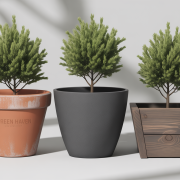House plants add a touch of natural beauty to any home. Whether you prefer something simple and classic or something exotic, there’s something special about having a living thing in your home that you can take care of. But not all houseplants require the same level of maintenance.
Some plants are simply not demanding when it comes to watering. Plants like cacti, succulents and air plants are some of the best options for homes with less water available.
These houseplants not only require little water but also help bring a sense of rustic charm to your home.
Low-Water House Plants
House plants are an easy and attractive way to add a bit of color, life, and greenery to your home. If you’re looking for low-water houseplants that are easy to care for and won’t need frequent watering, here are the top five:
Snake Plant
Snake plants are a great low-maintenance houseplant that only needs water every two to three weeks. These plants are very hardy and can survive in a variety of light levels, making them an excellent choice for just about any room in the home.
They do have some disadvantages, however, such as the fact that they can’t take too much direct sunlight and will burn if exposed to too much. They can also be tricky to repot, since their thick root system makes it hard to contain the plant in its new pot.
Aloe Vera
Aloe Vera is a popular succulent and one of the best house plants with low watering needs. This low-maintenance beauty can survive on its own with very little water and still thrive.
Aloe Vera plants have thick stems and leaves that store water, making them very drought tolerant. They also require bright light and warm temperatures in order to survive.
Aloe Vera plants are a great way to add a pop of color and texture to any room in your house.
ZZ Plant
The ZZ plant is another great option for low-water house plants.
It’s an evergreen succulent with thick, waxy leaves that can store water for long periods of time. You only need to water it once a month or so and it likes bright, indirect light.
Their disadvantage is that they are slightly more expensive than other low-water house plants.
Cacti
They are a unique type of plant that can be used to add interest and texture to any room, garden or landscape.
Cacti come in a wide variety of shapes, sizes, and colors, making them a great choice for creating visual interest in gardens and landscaping areas.
They are also incredibly tough plants that don’t require much maintenance, so they’re perfect for busy gardeners who don’t have a lot of time to devote to their plants.
When planting cacti, it’s important to remember that they require well-draining soil, so be sure to provide this essential element for the health of your plant.
You will need to water cacti only when the soil is dry to the touch.
Lastly, they need plenty of sunlight, so be sure to provide your cacti with enough bright light exposure each day.
Air Plants
Air plants are another great option for low-water house plants. These tropical plants don’t even need soil, just some water and indirect light! They absorb water and nutrients through their leaves, so a light misting of water once or twice a week is all that’s necessary.
Plus, air plants are very versatile. They can be hung from baskets or draped over branches for an eye-catching display.
Benefits For Those With Busy Lifestyles
Houseplants that require low watering needs are highly beneficial for those with busy lifestyles. These types of plants do not need to be watered as frequently as other plants, meaning they can go longer periods of time without needing attention from a gardener or plant-lover.
With these plants, you won’t have to worry about constantly checking and watering them, which can be a hassle when you are busy.
These plants are often more resistant to disease and pests because they don’t require as much water, making them easier to maintain. Because these plants are drought tolerant, they can survive in less hospitable environments with little access to water; this can be especially helpful when caring for indoor plants that may not have easy access to water.
How To Keep Your Plants Healthy And Thriving
Even though these plants are not demanding, there are some things which can help your house plants stay healthy and thriving.
Choose Drought-Tolerant Varieties
Some of the most common house plants that have low water requirements are succulents, snake plant, spider plant, and pothos. These plants can survive long periods without watering due to their natural adaptation to arid climates.
Plant Them In Well-Draining Soil
Well-draining soil is essential for plants that need less water, as it helps prevent overwatering which can lead to root rot. Choose a potting mix made specifically for houseplants, and add sand or perlite to help with drainage.
Place Them In A Sunny Area
Plants that have low water needs do best when placed in bright, sunny areas. Keep them away from drafts and direct air conditioning or heating vents as these can cause the plant to dry out quickly.
Allow The Soil To Completely Dry Out Before Watering
Plants with low water needs don’t need much water – only enough to moisten the soil. The best way to ensure your plant is getting enough water is to wait until the top inch of soil has completely dried out before watering.
Utilize Mulch
Adding a layer of mulch (such as pebbles or bark chips) on top of the soil helps retain moisture and reduce evaporation, which can help keep your plant from drying out too quickly.
Conclusion
Low-water houseplants provide a number of benefits, such as reducing humidity levels indoors and improving air quality. They are also easy to take care of, requiring less attention than other plants that need regular watering and can be placed in any room of the home or office.
Low water houseplants are an ideal addition to your home or office, as they are both aesthetically pleasing and beneficial to your health.
It is important to remember to research each plant before purchasing to make sure you can provide the right environment for it.













Comments